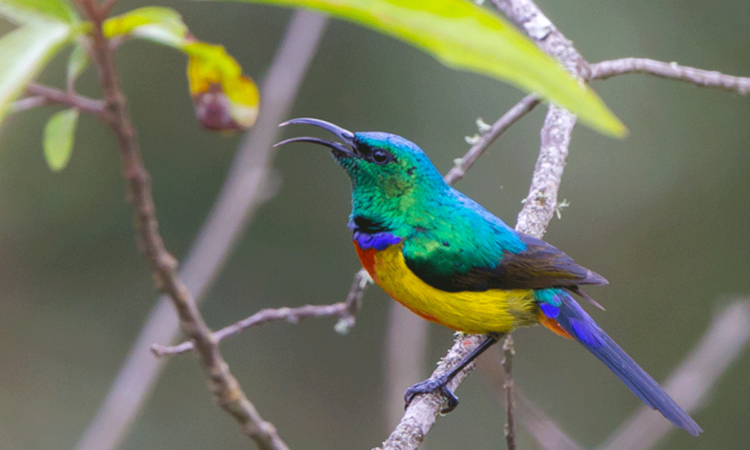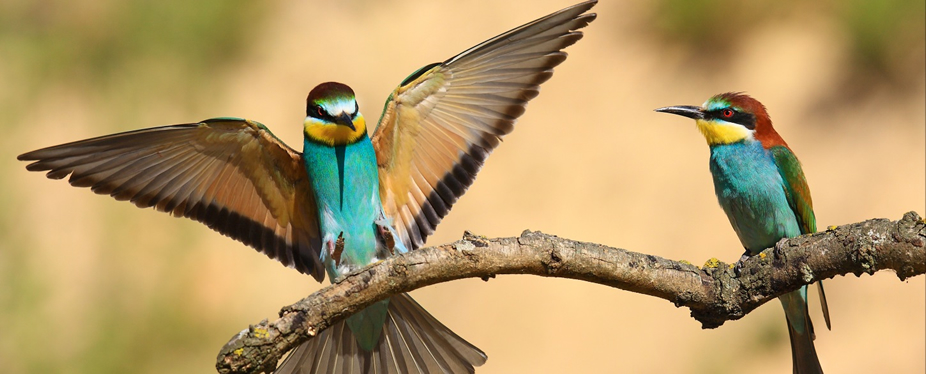
Birding in Volcanoes National Park
Birding in Volcanoes National Park: One of the most economical safaris in the country is birding at Volcanoes National Park. Unlike other activities like gorilla trekking, which requires a visitor to obtain a gorilla permit, all that is necessary for birding is to book and pay a few bucks and you are ready to go. Some tourists like to combine bird watching with additional activities such as gorilla trekking, golden monkey tracking, wildlife viewing, cultural excursions, chimp tracking, and more on a Rwanda birding vacation.
Volcanoes National Park is a birding paradise where most Rwandan tourists go to see birds. Volcanoes National Park, located in the northwest of Rwanda, is a tropical rain-forested park with spectacular views of the five volcano ranges. Birding at Volcanoes National Park is one of the best activities to do when visiting East Africa. According to the current study, Rwanda has over 700 bird species, with Volcanoes National Park accounting for 45% of them. This helps to explain why the park is such a popular birding destination in Rwanda.
Birding in Volcanoes National Park.
Bird viewing at Volcanoes National Park is one of the exciting activities done during Rwanda gorilla trekking safaris, and it provides tourists with an insight into the varied wildlife found in Rwanda’s famed lush rain forest.
Volcanoes National Park, located in the northwestern region of this little East and Central African country, is home to approximately 180 remarkable bird species. This 160 square kilometer National Park is well-known for gorilla trekking, but it has more to offer than only the endangered Mountain gorillas, and the birds are one of its most magnificent attractions. Thirteen of the total bird species found in this Park are native to the Albertine Rift, while 16 are endemic to the Virunga Mountains.
Notable Bird species in Volcanoes National Park.
Expect to witness the lovely francolin, weird weavers, Rwenzori turaco, Rwenzori double-collared sunbirds, Archer’s ground robin, Collared Apalis, Red-faced woodland warblers, and Dusky Crimsonwing among others when you visit Volcanoes National Park for a birding safari.
Birding at Volcanoes National Park, like other activities, begins in the morning with a briefing at the Park Headquarters before traveling into the bush to find some of the Park’s residents. You’re likely to observe buffaloes, bushbucks, primates, and butterflies when looking for bird species at Volcanoes National Park.
When is the best time for birding in Volcanoes National Park?

Despite the fact that Volcanoes National Park is usually shrouded in mist and forest routes are wet, muddy, and perilous during the rainy season in March, April, May, October, and November, the best time for bird watching is all year. The rainy season, especially between April and November, is ideal for viewing migratory birds.
What to pack for when birding in Volcanoes National Park?
A pair of binoculars for spotting small and distant species, a good camera with a good lens and enough memory, a guidebook, bird journal, long trousers, and long-sleeved shirts to protect your hands from being scratched, a hat, sunglasses, closed shoes, cotton socks, a rain jacket because rain cannot be predicted, a backpack for carrying the items you will need while bird watching, energy snacks, and a first aid kit, to name a few.
Where to stay when birding in Volcanoes National Park?
There are numerous places to stay while birding in Volcanoes National Park, but some of the most popular are Bisate Lodge, Volcano Manor, Bishop’s House, Five Volcanoes Boutique Hotel, Sabyinyo Silverback Lodge, Virunga Resort Inn & Spa Hotel, Kinigi Guesthouse, Tiloreza Volcanoes Eco Lodge, Hotel Muhabura, Le Palme Hotel, Mountain Gorilla View Lodge, Da Vinci Gorilla Lodge, Le Bambou Gorilla Lodge, Virunga Lodge, Fatima Hotel, the One & Only Gorilla’s Nest, and Amakoro Songa Lodge among others.
Other activities to combine with birding in Volcanoes National Park.
Gorilla Trekking
Volcanoes National Park in Rwanda is one of only four national parks in the world where mountain gorillas may be found, and gorilla trekking is the main attraction that pulls so many tourists to this breathtaking region. Because mountain gorillas are critically endangered, witnessing them in their natural habitat is immensely rewarding and creates lifetime memories.
Mountain gorillas are located in three countries: Uganda, the Democratic Republic of the Congo, and Rwanda. Mountain gorillas are only found in Rwanda’s Volcanoes National Park, where 12 habituated gorilla groups are available for trekking. Volcanoes National Park Rwanda is home to Agasha, Amahoro, Umubano, Ugenda, Susa, Kwitonda, Bwenge, Sabyinyo, Hirwa, Karisimbi, and other habituated gorilla families.
Volcanoes National Park gorilla trekking begins at 7 a.m. with a briefing at Kinigi Park headquarters, after which travelers are assigned to a gorilla family and undertake a guided journey in search of the gorillas. Trekking might take 2-5 hours, depending on the family being observed and the walking speed of the individuals. When they find gorillas, tourists are given an hour to observe their behaviors, learn about them, and take photos.
Hiking to Dian Fossey Gravesite.
Dian Fossey Grave trekking is an exciting activity to perform when visiting Rwanda’s Volcanoes National Park. Dian Fossey’s tomb hiking is usually a popular choice for travelers on their Rwanda gorilla trekking safari. When you see where this prominent American primatologist was buried, the journey is worthwhile.
Depending on your level of fitness, the Dian Fossey tomb hike takes between 1 and 3 hours to complete. Proper hiking shoes are necessary because the trails are generally muddy and slippery due to the rain. Pants and a long-sleeved shirt are also required for protection from stinging nettles and spiky bushes.
Visit Ibyiwacu Village a.k.a The Gorilla Guardians’ Village
You might go on a Rwanda culture travel experience to Ibyi’wacu hamlet, which is adjacent to Volcanoes National Park. It’s always fascinating to learn about Rwandan culture and lifestyle, as well as the country’s history.
Golden Monkey Trekking
The park is one of just two in East Africa where golden monkey tracking is possible; the other being Uganda’s Mgahinga Gorilla National Park, located in the country’s southwest. Golden monkeys are a rare and endangered monkey species. Because the monkeys feed on the lower slopes of the mountain, which are fairly accessible, golden monkey tracking is less difficult than gorilla tracking. It is less expensive than gorilla trekking and may be combined. The permit is USD 100.
Hiking and Mountain Climbing.
The shortest hike is to Lake Ngezi, a lovely little lake buried in a volcanic depression at the foot of Mount Bisoke. It takes around three hours in total and is rather straightforward to navigate, with the possibility of seeing wildlife and gazing across to the Congolese woodlands along the way.
Those who want to ascend Mount Bisoke (3,700m) will be rewarded with a crater lake. This journey might take anywhere from five to a full day. Mount Karisimbi, which translates as “white shell,” alludes to the white-capped cloud cover that blankets the summit on a regular basis. At 4,507m, it’s a challenging but rewarding two-day climb with camping along the way.
How to get to Volcanoes National Park?
Volcanoes National Park is located in northern Rwanda, approximately 105 kilometers/2-3 hours’ drive from Kigali, Rwanda’s capital city, and the starting point for the expedition. This park may be reached by air or road, with the former providing scheduled flights or chartering a plane from Kigali International Airport to Kamembe Airport and then driving to the park.


